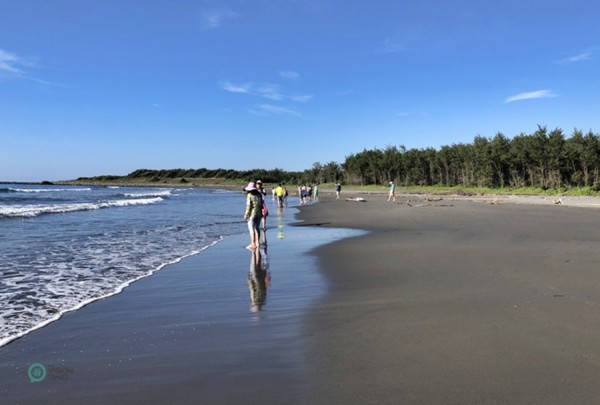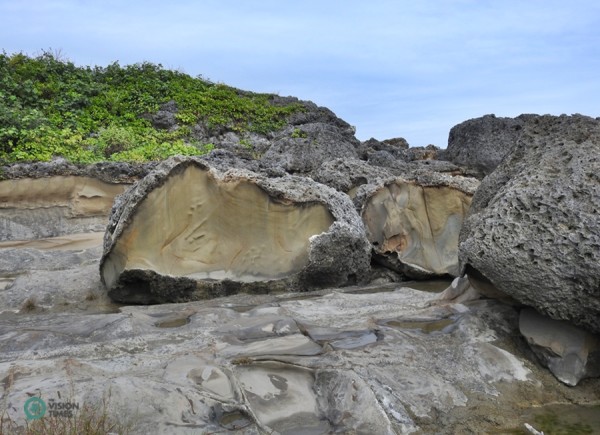Starting north of Hualien City and ending south of Taitung City in eastern Taiwan, the Hualien-Taitung Coastal Highway (花東海岸公路), also known as Highway No. 11, is a picturesque coastal highway in Taiwan.

Spanning a length of about 177 km (110 miles) along the Pacific Ocean, in addition to the picturesque scenes of the sky and the sea meeting at the horizon in the distance, there are also many breathtaking scenic sites along the coastal highway.
Please watch the following video of the picturesque coastal highway in eastern Taiwan.
There are many attractions along the coastal highway
The Fengbi Skywalk (豐濱天空步道)
The Fengbin Skywalk in Hualien County’s Fengbin Township (豐濱鄉) has become one of the most striking tourist attractions along Highway No. 11 since it was opened to the public in 2017. It is a 150-meter-long stunning footpath with a 30-meter-long glass-bottomed path built on the cliffs 50 meters above sea level.

The footpath used to be the only trail for Taiwan’s indigenous tribes — Amis (阿美族), Kavalan (噶瑪蘭族), and Sakizaya (撒奇萊雅族) — to cross the cliffs. It was referred to as “Qinbuzhizi” (親不知子斷崖), as the cliffs were so steep that a mother who carried her son to cross the cliffs might not notice the baby falling into the sea below while passing the footpath.

The Shimen Cave (石門洞)
Located at the 60-kilometer mark of Highway No. 11 is the Shimen Recreation Area (石門遊憩區). There are many amazing rock formations formed by sea erosion at the Recreation Area, including some stunning sea caves. Among them is the unique entrance to the Shimen Cave, also called “Mochi” or “March Cave” (麻糬洞) because of its shape.

Legend has it that there was a fight between aboriginal tribes, and the warriors stayed overnight in the cave where they ate mochi (sticky rice cake) and raw cured pork. Shimen Cave still has the mochi and the raw cured pork left behind by the warriors in the shape of sea eroded openings, the bigger one resembles mochi and a smaller one raw cured pork.

A more contemporary comparison suggests the entrance’s shape resembles that of a Nissan March, which used to be one of the popular models in Taiwan. As a result, Taiwanese people commonly refer to the cave as “March Cave.” Shimen Cave has become more popular among Taiwanese after Oscar-winning director Martin Scorsese picked the Cave as one of the filming sites for his film entitled Silence in 2015.

The Baxiandong Cave (Eight-Immortal Cave 八仙洞)
Baxiandong (八仙洞) is a site of archaeological importance along Highway No. 11. There are dozens of caves of different sizes that were formed by the erosion of seawater on the giant cliffs facing the Pacific Ocean. Baxiandong is the oldest prehistorical site that has been found in Taiwan and has been designated as a first-class national historical site. A number of historic items have been unearthed in these caves. The Paleolithic era in the Baxiandong Archaeological Site can be traced back over 3,000 years.

As the surroundings of Baxiandong resemble what is depicted in the folklore of the Eight Immortals crossing the ocean, Baxiandong was thus so named. Additionally, there is a cozy park in front of these caves with plank trails and pavilions that allow visitors to take in the beautiful scenery around the Pacific Ocean.

The Sanxiantai (Platform of the Three Immortals 三仙台)
Sanxiantai is one of the most popular tourist attractions on Highway No. 11, which is known for its iconic footbridge in the shape of a sea dragon. Spanning about 400 m (1,312 ft), the spectacular footbridge was constructed in 1987 and is composed of eight arches that lead to the largest island of Sanxiantai.

Sanxiantai (Platform of the Three Immortals) was so named because legend has it that three of the Eight Taoist Immortals had once rested on the island, leaving three pairs of footprints, and the three large standing rocks on the island are symbolic of the three immortals. Covering an area of 22 hectares (54 acres), the island has a trail stretching about 1.57 km (0.98 mi). It’s an ideal destination to take a stroll to enjoy the unique rock formations and nature’s beauty.

The Torik Beach Sky Mirror (都歷海灘天空之鏡)
Located in front of the rice paddies adjacent to Highway No. 11 in Taitung County’s Chenggong (成功) Township is Torik Beach (都歷海灘). As the shoal on the beach resembles a natural mirror that reflects the azure sky and white clouds, it creates many unique photography opportunities for a breathtaking seascape of the endless sea mirroring the skies above.

Torik Beach has become a new uncharted attraction for tourists to explore the phenomenon of the Sky Mirror (天空之鏡) in Taiwan. Many visitors just go there to take mind-blowing photos of people jumping or other dynamic poses. The best time to experience this reflective phenomenon and capture the Sky Mirror is one hour before or after the low tide.

Xiaoyeliu (Little Yeliu小野柳)
Xiaoyeliu is a small coastline park in Taitung County that is famous for its amazing rock formations. As its unique geological landscape is similar to that found at the Yeliu Geopark in northern Taiwan’s New Taipei City, it is thus called the Little Yeliu.

There are a wide variety of fascinating rock formations eroded by sea waves. Some are undulating like waves, others are like cuesta, while still others resemble animals or objects in various forms, such as a turtle, a mushroom, tofu, a honeycomb, or a fungus — you name it.









